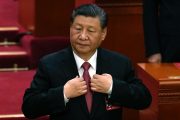
Both former and current Chinese government officials have already begun to make statements that seem to indicate that the communist nation isn’t all that committed to fulfilling its climate promises.
Key Chinese tenets of the Paris Climate Accord and, more recently, the COP26 climate conference in Scotland, include the communist nation’s pledge to reach peak emissions by 2030 and to reach “carbon neutrality” by 2060. But these goals appear to be more aspirational than a concrete plan, according to some Chinese officials.
At a conference in Beijing on Saturday, former finance minister Lou Jiwei said that China would “strive to” reach the goals set out in the Paris Accord and COP26, but “striving” might not mean actually “achieving.”
Lou played the “developing country” card.
“We are a developing country. We should bear common but differentiated responsibilities that are different from developed countries,” Lou told the assembly gathered by the China Centre for International Economic Exchanges.
Current government official Han Wenxiu, from the Central Committee for Financial and Economic Affairs, indicated that the stated climate goals of Communist China were secondary to its industrial goals.
“[The carbon targets] should not affect the country’s overall economic and social development,” Han said.
On Friday, Chinese leader Xi Jingping and the nation’s politburo released a statement saying, “Achieving carbon peak and carbon neutrality goals … requires unwavering efforts but it can’t be achieved in just one battle.”
The politburo’s statement also stressed that fossil fuels should only be phased out “based on” the availability of safe and reliable alternative sources of energy. While wind and solar might be “safe” from an emissions standpoint, they are currently far from reliable. The Chinese statement also stressed the need to continue to use “clean and efficient” coal, considering the fossil fuel’s dominance in energy generation for the nation.
According to a report by the Center for Research on Energy and Clean Air, China is currently building 43 new coal-fired power plants along with 18 new coal-fired blast furnaces as part of the government’s current five-year-plan.
In the past two months, more than half of China’s provinces have resorted to rationing electricity. According to one Chinese academic, the government is beginning to understand the difficulty of transitioning from coal and other fossil fuels in the time period presented.
“Wind and solar power account for about 9 percent of China’s electricity generation. The dominant role of coal in China’s power and energy structure cannot be changed in a short time,” said Lin Boqiang, dean of Xiamen University’s China Institute for Studies in Energy Policy.
Those provincial power outages might have prompted a Chinese reassessment of their stated climate goals, which are already considered lackluster by climate alarmists.
“People have realised that the energy transition is hard and we are far from achieving it,” said Ma Jun, the director of the Institute of Public and Environmental Affairs, a Beijing based NGO.
“The central economic conference emphasised that the phasing-out of fossil fuels should be based on safe and reliable new energy alternatives, indicating that the replacements have not been building up and we cannot phase out fossil fuels in a quick way,” Ma explained.
So the Chinese politburo and leader Xi seem to be realizing what many of us already knew — that there are currently no adequate replacements for fossil fuels as of yet. Hence, their public shift in claiming that their emissions goals are more aspirational than concrete.
This more cavalier Chinese attitude toward climate goals must be news to President Biden and his “climate envoy” John Kerry, who hailed the Chinese commitment to reducing emissions and even released a joint statement with the communist nation regarding a shared commitment to address the so-called climate crisis in the wake of COP26.
Kerry called the joint statement a “roadmap for our future collaboration.” Kerry’s counterpart, Xie Zhenhua, said the statement showed there is “more agreement between China and the U.S. than divergence.”
But the statement is full of vague language and promises of “cooperation.” Nowhere in the statement does China promise not to build new coal-fired plants. Instead, it claims that the two countries are “committed to tackling the climate crisis by strengthening implementation of the Paris Agreement,” and “[recognizing] the significance of adaptation in addressing the climate crisis.”
Chinese officials appear to be somewhat interested in having the world believe that they have a plan to become carbon-neutral in the coming decades. But they are far less interested in actually accomplishing that goal.




